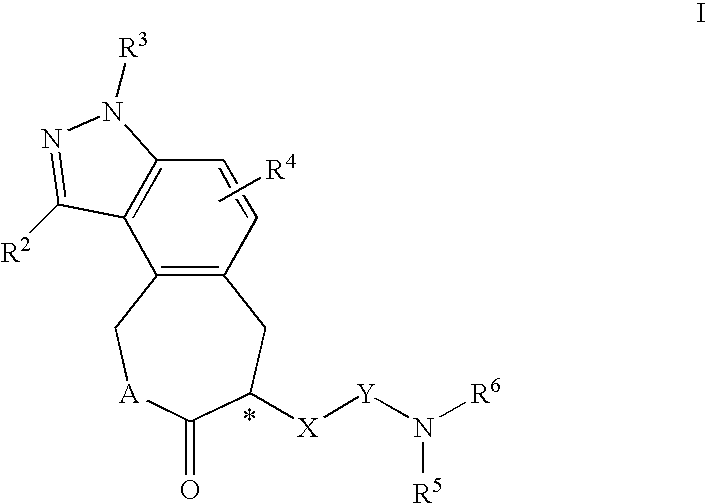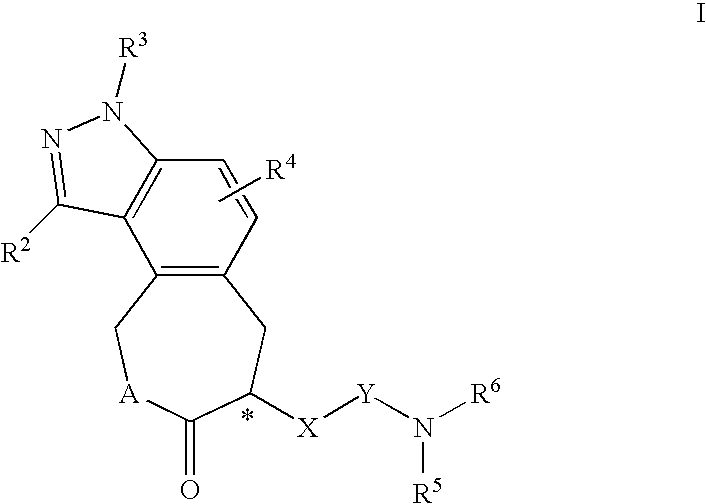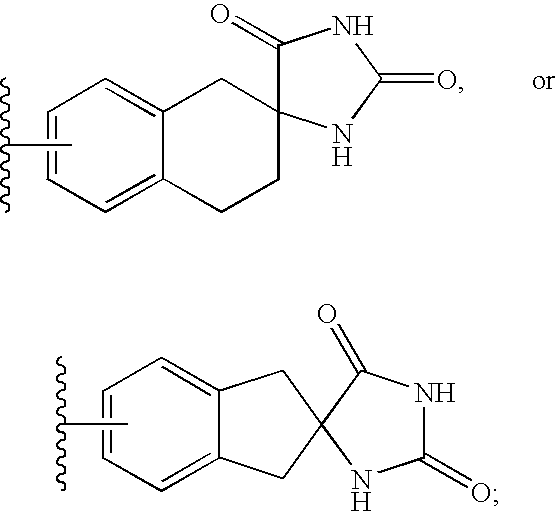Constrained compounds as CGRP-receptor antagonists
a technology of cgrp and receptor, which is applied in the direction of heterocyclic compound active ingredients, drug compositions, biocide, etc., can solve the problem of lack of molecular evidence for cgrpsub>2
- Summary
- Abstract
- Description
- Claims
- Application Information
AI Technical Summary
Problems solved by technology
Method used
Image
Examples
example 1
[0548]
(S)-1,4-dibromo-7-(2-oxo-2-(4-(2-oxo-1,2-dihydroquinolin-3-yl)piperidin-1-yl)ethyl)-9-(2,2,2-trifluoroethyl)-6,7,9,10-tetrahydroazepino[3,4-e]indazol-8(3H)-one
[0549](S)-2-(1,4-Dibromo-8-oxo-9-(2,2,2-trifluoroethyl)-3,6,7,8,9,10-hexahydroazepino[3,4-e]indazol-7-yl)acetic acid (44 mg, 0.088 mmol) was dissolved in N,N-dimethylformamide (1.5 mL). N,N-Diisopropylethylamine (70 μl, 0.402 mmol) was added to the mixture followed by TBTU (31.5 mg, 0.098 mmol). 3-(Piperidin-4-yl)quinolin-2(1H)-one hydrochloride (25.7 mg, 0.097 mmol) was added to the mixture. Reaction stirred at room temperature for 1.5 hours. Reaction was quenched with 50% acetonitrile-water. Mixture was purified by reverse phase prep HPLC (acetonitrile-water-trifluoroacetic acid). Acetonitrile was removed from the fractions by roto-vap. Remaining aqueous was made basic with aqueous sodium bicarbonate. Material was extracted twice with ethyl acetate and the aqueous phase was discarded. Organics were dried MgSO4, filtere...
example 2
[0550]
(S)-1,4-dibromo-7-(2-(4-(8-fluoro-2-oxo-1,2-dihydroquinolin-3-yl)piperidin-1-yl)-2-oxoethyl)-9-(2,2,2-trifluoroethyl)-6,7,9,10-tetrahydroazepino[3,4-e]indazol-8(3H)-one
[0551](S)-2-(1,4-Dibromo-8-oxo-9-(2,2,2-trifluoroethyl)-3,6,7,8,9,10-hexahydroazepino[3,4-e]indazol-7-yl)acetic acid (49 mg, 0.098 mmol) was dissolved in N,N-dimethylformamide (1.5 mL). N,N-Diisopropylethylamine (70 μl, 0.402 mmol) was added to the mixture followed by TBTU (34.5 mg, 0.107 mmol). 8-Fluoro-3-(piperidin-4-yl)quinolin-2(1H)-one hydrochloride (33.0 mg, 0.117 mmol) was added to the mixture. Reaction stirred at room temperature for 3.5 hours. Reaction was quenched with 50% acetonitrile-water. Material was purified by reverse phase prep HPLC (acetonitrile-water-trifluoroacetic acid). Acetonitrile was removed from the fractions by roto-vap. Remaining aqueous was made basic with aqueous sodium bicarbonate. Material was extracted twice with ethyl acetate and the aqueous phase was discarded. Organics were d...
example 3
[0552]
(S)-4-bromo-7-(2-oxo-2-(4-(2-oxo-1,2-dihydroquinolin-3-yl)piperidin-1-yl)ethyl)-6,7-dihydro-3H-oxepino[3,4-e]indazol-8(10H)-one
[0553](S)-2-(4-Bromo-8-oxo-6,7,8,10-tetrahydro-3H-oxepino[3,4-e]indazol-7-yl)acetic acid (90 mg, 0.265 mmol) was dissolved in N,N-dimethylformamide (2.5 mL). N,N-Diisopropylethylamine (150 μl, 0.861 mmol) was added to the mixture followed by TBTU (94.5 mg, 0.294 mmol). 3-(Piperidin-4-yl)quinolin-2(1H)-one hydrochloride (90.3 mg, 0.341 mmol) was added to the reaction mixture. Reaction stirred at room temperature for 3 hours. Reaction was quenched with water. Material was extracted twice with ethyl acetate. Organic phase was filtered. Filtrate was concentrated by roto-vap. Residue was purified by prep HPLC (acetonitrile-water-trifluoroacetic acid). Acetonitrile was removed from the fractions by roto-vap. Remaining aqueous was made basic with aqueous sodium bicarbonate. Material was extracted twice with ethyl acetate. Organics were dried MgSO4, filtered a...
PUM
| Property | Measurement | Unit |
|---|---|---|
| pH | aaaaa | aaaaa |
| volume | aaaaa | aaaaa |
| volume | aaaaa | aaaaa |
Abstract
Description
Claims
Application Information
 Login to View More
Login to View More - R&D
- Intellectual Property
- Life Sciences
- Materials
- Tech Scout
- Unparalleled Data Quality
- Higher Quality Content
- 60% Fewer Hallucinations
Browse by: Latest US Patents, China's latest patents, Technical Efficacy Thesaurus, Application Domain, Technology Topic, Popular Technical Reports.
© 2025 PatSnap. All rights reserved.Legal|Privacy policy|Modern Slavery Act Transparency Statement|Sitemap|About US| Contact US: help@patsnap.com



